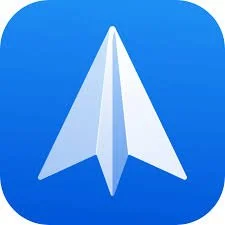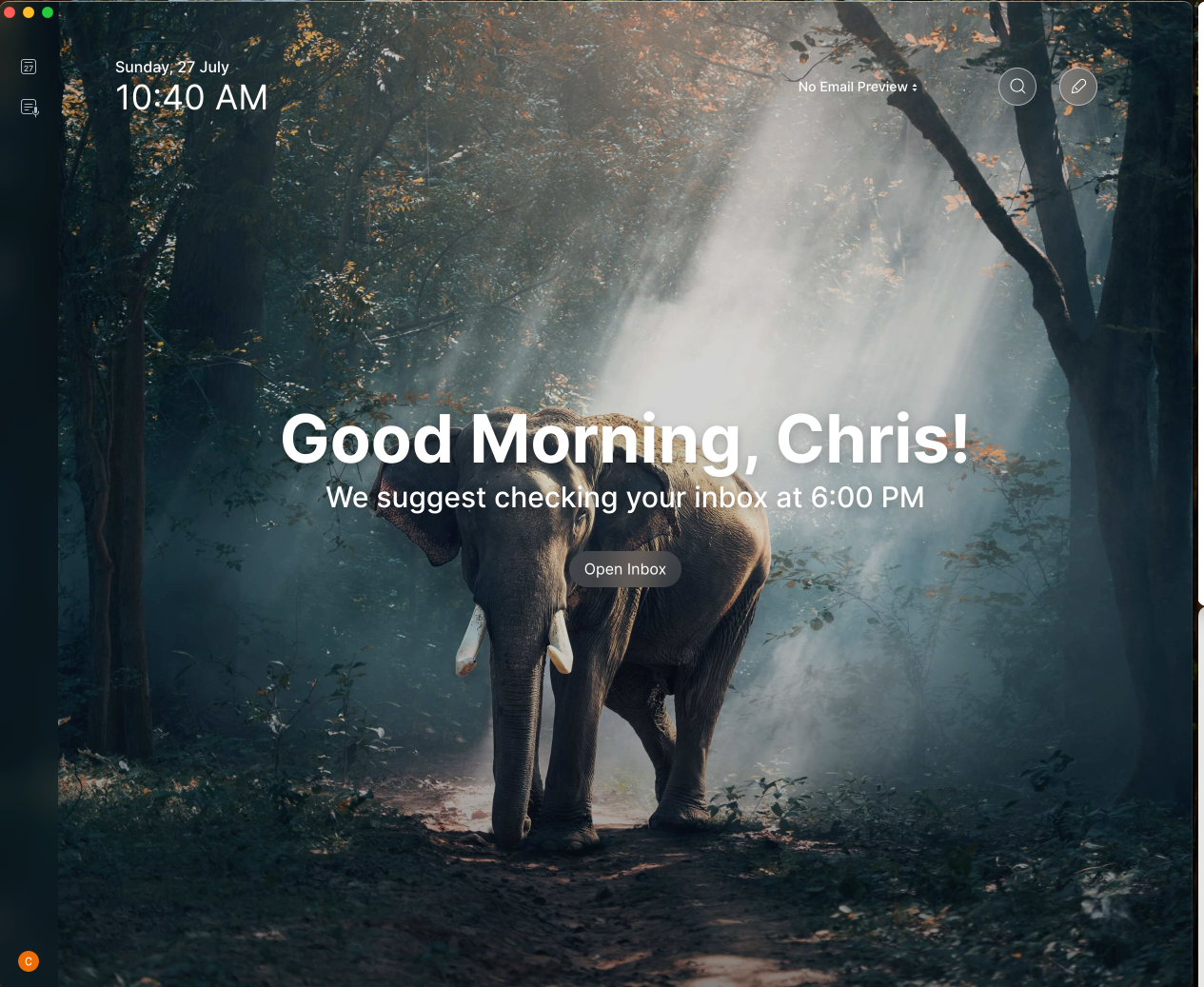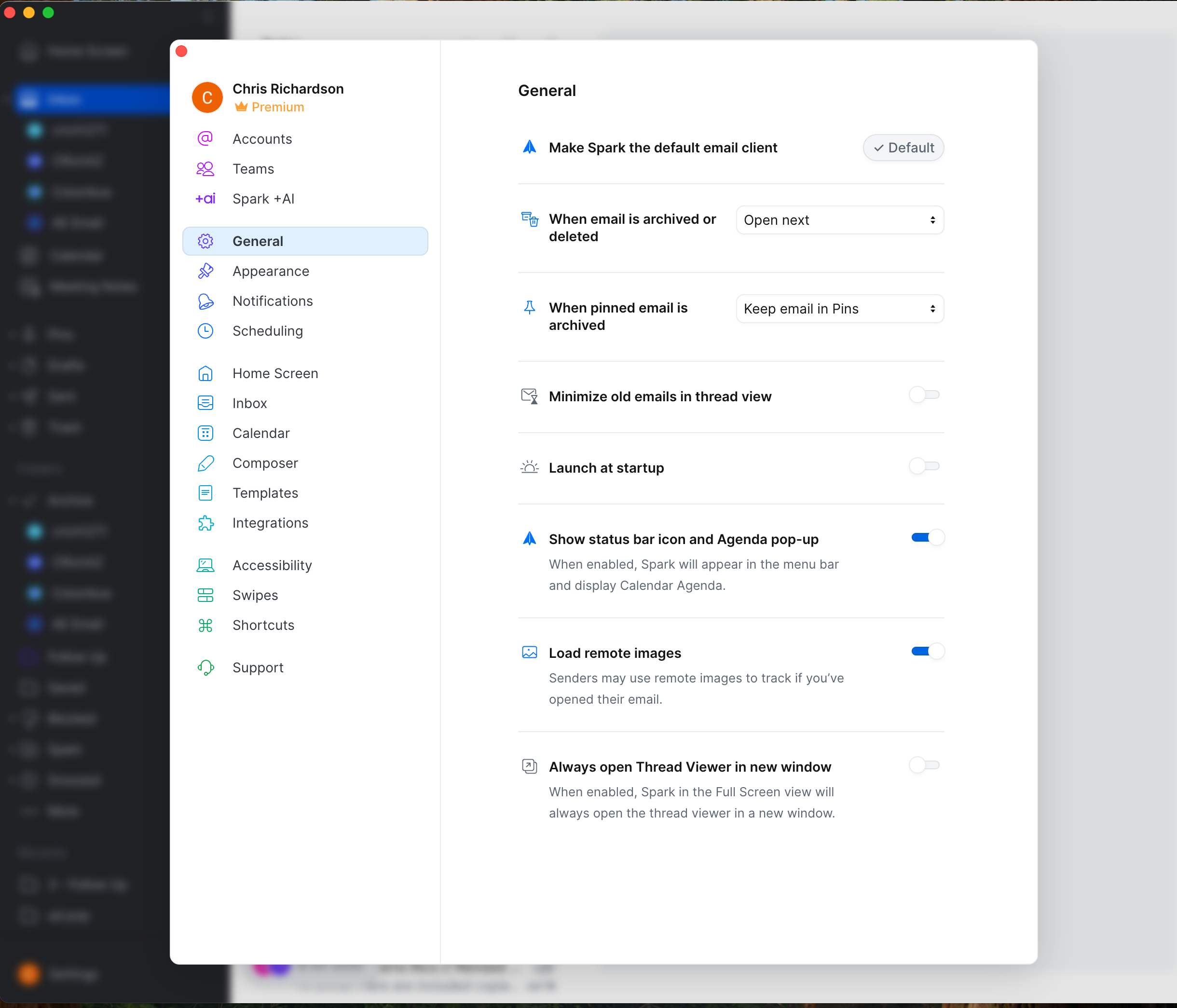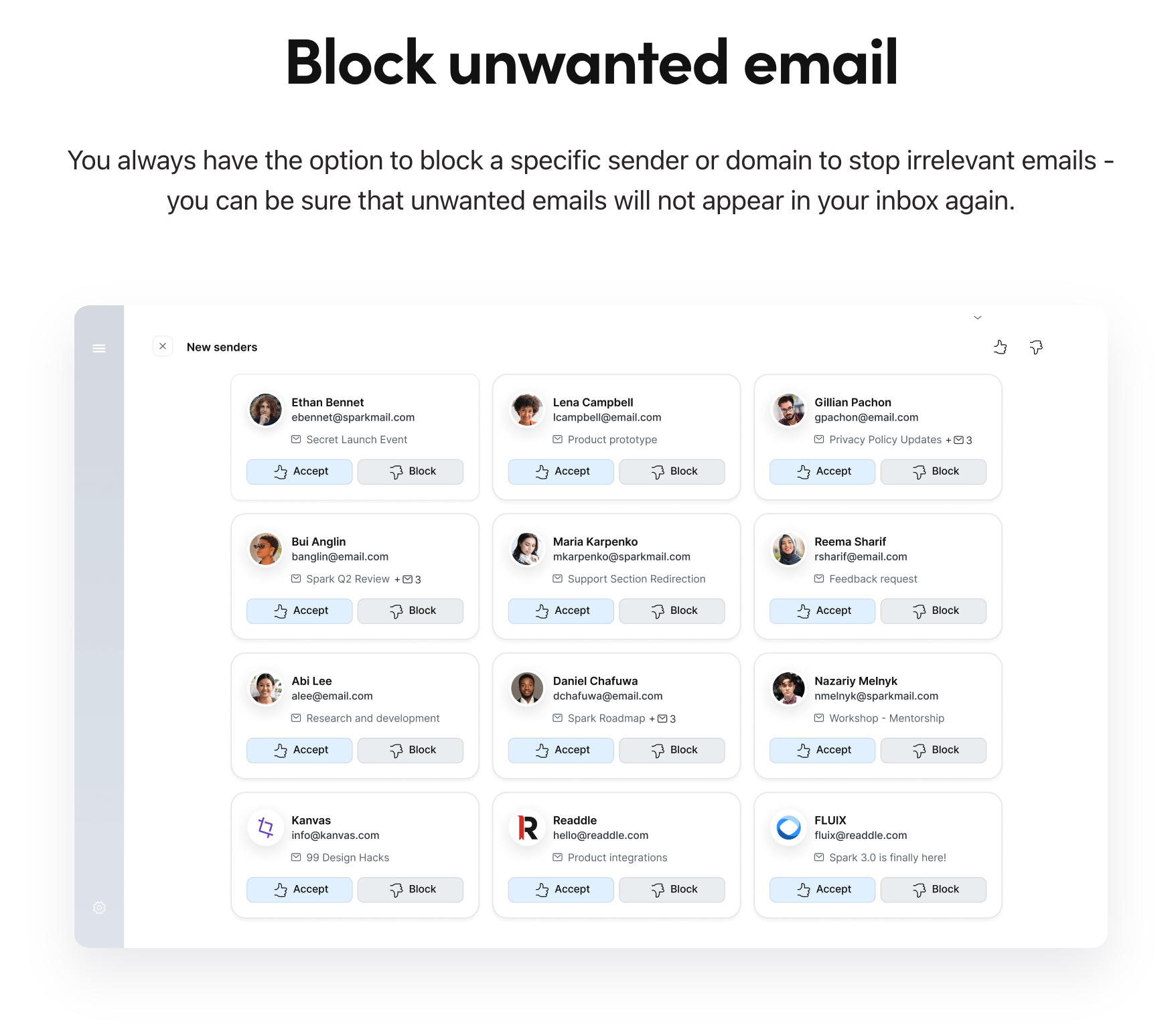Tech Tip — Spark Mail
Drowning in emails? Simply jumping to a new email app won't be your lifeline. While tools like Spark Mail offer impressive features, the hard truth is that without addressing your core email habits, you'll soon find yourself back in the same overwhelming inbox situation. Instead, I recommend taking some time to capture your regular email workflow, how you process email, how you store email, and how you follow up on email. Then write down what you would like to do differently. You can only control your side of the equation. Again, regardless of email application, you don’t (completely) control what comes to you. How you process email is your best solution for a better email experience. Once you have an idea of what you’re currently doing and what you would like it to be, then use those deltas to find solutions with the tools available.
You may also find that how you currently work and the way you want to work are not that different, and free applications like Apple Mail, Gmail, or Outlook can do what you would like. All three of those applications are very good at what they do. Gmail provides the most options as a free tool, but requires your work to be done in a browser for the most part (there are some desktop options). Plus, your email needs to be Google or Gmail based.
Outlook, while I note as free, is part of a O356 account, so it’s free if you have that. You may be using Outlook in a work environment, which can lead to some limits on your ability to use all the connection tools that Outlook has to offer. You can do many of the things that Spark offers in Outlook if you have the ability to use the plug-ins available to users.
Finally, Apple Mail is great for anyone in the Apple ecosystem. If you’re an iPhone user, you’ve likely used this app as well. Apple Mail can handle accounts from any email provider. You can have Apple (@icloud.com) accounts, Gmail accounts, Yahoo, Outlook, or almost any other. It is easy to use and have any general email management tool you need. Honestly, for most people is it is an excellent solution and covers the necessary basics of email management.
What Is Spark Mail?
With those options already available and most of them free or likely included with something you already have, why look for a different solution? That is a fair question, and as I mentioned above, it is really a matter of preference and how you want to work. I had tried Spark Mail a while back, but could never use it fully due to limitations of the work servers and allowances for outside applications managing email. When I had the chance to choose what I wanted for an email application, I figured I would give it a try again.
Spark Mail Landing Page
Spark is clearly aiming to be a one-stop shop for mail and calendar. It does have a built-in calendar program. It works fine, and it appears some handy additional features will be coming soon, such as allowing others to schedule time with you automatically (eliminating back and forth), and having a personal link for a calendar time (show others your availability and allow them to schedule with you.) These will be helpful. The major downside I see with this feature is I cannot have a separate window open with just my calendar. I hope this will be on their roadmap soon, as this could solve the need for separate calendar applications. One of the best parts of Microsoft Outlook is the seamlessness of the mail and calendar components.
I do think Spark Mail offers a lot of really good options. For a relatively inexpensive paid solution, this application provides a lot of value and options for new workflows. You just have to be ready and willing to commit to working email in new ways. And, while I describe it as a paid solution, Spark does have a free version that is a solid choice and is available on all platforms.
Here are some of the highlights about why I like Spark Mail and have chosen this as my current email tool of choice.
Provides Many Options
Spark is an opinionated email application. My guess is that most people will either love it or hate it right from the beginning. If you absolutely cannot stand having your email conversations collected together as a ‘conversation view,’ this application will not work for you. In fact, that was almost a dealbreaker for me. I am not a huge fan of ‘conversation view’ for emails. And Spark handles them in an awkward way at times. I have missed when new updates come in a few times because of it, tacking the new email on to the existing string of emails. However, I have become accustomed to that and as you learn how to work with it, it actually makes a lot of sense to have the full history in one place. I will admit I am still getting used to that.
Spark Mail Options Pane 1
Spark Mail Options Pane 2
Challenge Accepted
If you are up for the challenge of rethinking your inbox and how it is managed and processed, then Spark will give you a plenty of options. It is the most configurable mail application I have come across. Almost everything has an option for the user to select from if they want.
I would say Spark encourages a simple system. If you rely heavily on a folder system (like Outlook or Apple Mail), this will take getting used to. Spark follows more of a unified archive system or tagging (like Google/Gmail). I have found the search capabilities to be very good, so a unified archive box is fine with me. It does provide options to ‘set aside’ an email, and you can create folders if you choose. I created a ‘Follow Up’ folder to make it easier to move things out of the inbox, yet have a specific place to check. This can be helpful for when you are waiting on feedback before you can proceed.
Other Organization
I like the set-up in Spark to automatically move some emails to Newsletters, and others to Notifications. It is similar to the automatic sorting you get in Gmail or Apple Mail now. Outlook has its Focused Inbox, which essentially does the same thing. For most, that sort of action is enough. Spark has an easy interface for blocking emails and sending emails to spam, which is nice. You can easily look in those folders to make sure you’re missing anything. Spark is somewhat unique in asking you to ‘approve’ new senders. When an email comes in from a sender it doesn’t recognize, you get an opportunity to ‘accept’ or ‘block’ that sender. This is a nice part of the workflow that doesn’t feel like a lot of extra work.
Block or Allow
Spark is somewhat unique in asking you to ‘approve’ new senders. When an email comes in from a sender it doesn’t recognize, you get an opportunity to ‘accept’ or ‘block’ that sender. This is a nice part of the workflow that doesn’t feel like a lot of extra work. It really helps to make a decision right there on whether you want to see stuff from that person regularly. Do they deserve your time in your inbox? (You can always change your mind later). This top level filtering can ensure you do not spend a lot of extra time managing emails you really don’t need to see. I would recommend this is something you manage each month to see what may still be getting through. A quick monthly audit of which emails you receive regularly could be moved to as ’Spam’ or ‘Block’. Again, you can always review these folders to ensure you are not missing anything and change the settings.
Spark Mail Accept or Block
AI. Because Everyone Has AI
Spark Mail does have a built-in AI function that can help review and write emails for you. The AI can be helpful, but this still requires a lot of reviewing and reading what it uses for responses. I don’t think this is currently any better or worse than the tools in other mail applications. This could be something that improves as you use it, but you have to commit to letting AI do that for you for a period of time. I have not reached that level of confidence yet, or allowed myself to let go of that part.
Continued Improvement
Oddly, until very recently, you could not open a completely separate window when composing a new email. It would open it within the application, and you could make it the size of your (Spark) window or have it in a smaller compose space, but still not be able to independently work on other emails at the same time. It couldn’t be moved or resized, except to make it full screen. it was odd for such a modern email application. I am happy to report that they have fixed this. Not surprisingly, they said it was their most requested feature. I bet it was. It will silly not to have that option before. Problem solved.
The nice thing here is that Readdle (the vendor behind Spark Mail) is committed to continued improvement. That is an important element in applications today. Applications that are not being actively supported beyond basic bug fixes can get stale quickly. It is clear this is an application that is continuing to receive updates and enhancements. That is a good sign.
A Bonus Feature
This could be a feature mentioned under AI, but I wanted to call it out separately. The ‘Meeting Notes’ feature may be reason enough to keep Spark Mail in my active application selection. The ‘Meeting Notes’ allows AI to capture meeting notes for any of your calls. It will work with calls on Microsoft Teams, Zoom, Google Meet, or any other meeting application. It will automatically remind you and sync with your calendar, so it knows when your meetings are and offers to join (pops up a ‘join’ button, and a reminder to begin the transcript.) This is unobtrusive to others on the call, which I think is a nice feature. After the call it will provide a summary of the meeting with notes, and actions. (These are also configurable in Settings.) It also provides a full transcript of the call with time stamps. From what I have seen, it is excellent. The capture is highly accurate and the outputs extremely useful. Additionally, if you have a phone call from your phone, used on speaker, Meeting Notes can capture that call as well. This is an outstanding feature and well worth using. This alone could be worth the monthly fee for this application.
Spark Mail Meeting Notes
Spark Mail Meeting Notes Summary
What’s The Verdict?
I am going to continue to I use Spark as my primary email client. I think I still have a lot to learn in how I can use it better and to its full potential. I will likely still check in with Apple Mail to see how it continues to evolve. But, for now, Spark has all the options and features I need. I don’t love how it handles the conversation strong of emails; however, I can work with it. That may still be a matter of my willingness to try to work email in a slightly different way, which could be more efficient in the long run.
The fact that Spark is a part of Setapp, and I get the premium version included, makes this a no-brainer. It allows me to cancel my subscription to SaneBox, which was used to automatically sort emails for me as well. Eliminating that essentially pays for my annual Setapp subscription, so the access to Spark through that application pays for itself. Plus, I have access to more than 200 other applications, several of which I use regularly.
There is no perfect email application solution. Email, inherently, still sucks, but there is no immediate change on the horizon for its use and overuse. Managing the process becomes the best way to adapt and manage the world we live in. Spark has made it a lot easier in many ways. If I take full advantage of the tools it offers, it can help even more. I suspect you would find the same things.
What do you think? Could Spark Mail help you tame your Email Monster?
Get leadership tips and new articles you can use directly to your inbox. Join the thousands of other leaders continuing your leadership development journey with **Effective Retail Leader.com. **
DISCLAIMER: I participate in the Amazon Services LLC Associates Program, an affiliate advertising program designed to provide a means for me to earn fees by linking to Amazon.com and affiliated sites. Other links to third-party products and services may also be affiliate links.








